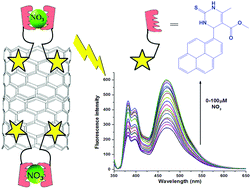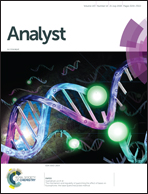Development of pyrene-stacked carbon nanotube-based hybrid: measurement of NO3− ions using fluorescence spectroscopy†
Abstract
Non-covalent bonding via π–π stacking is in demand these days because it does not affect the structure of the carbon nanotube (CNT). Herein, a hybrid material was fabricated via π–π stacking between the aromatic rings of carbon nanotubes and a dihydropyrimidone-based pyrene derivative. The developed CNT@pyrene hybrid material was fully characterized using SEM, EDX, TEM, XRD, and FTIR techniques. The hybrid was developed to improve the heat transport in the hybrid solution by anion addition. The emission profile of the developed hybrid was screened against TBA salts of different anions in EtOH–H2O (10–90% v/v) solvent system to identify the anion that can interact with the hybrid. The hybrid exhibited high sensitivity and selectivity towards NO3− ions with 1.5-fold enhancement in fluorescence intensity, while other anions neither showed significant responses nor interfered in the sensor's response. The limit of NO3− ions detection was found to be 8.1 nM, calculated using the 3-sigma method. It was observed that the proposed hybrid sensor showed stable response at different pH and diverse salt concentrations. The binding mechanism was elucidated by DFT-based theoretical calculations. Real sample analysis was performed for the detection of NO3− concentrations in local water bodies with accuracy as high as 95%. Viscosity and thermal conductivity experiments were performed to measure the effect of concentration, temperature, and pH on the NO3− response.



 Please wait while we load your content...
Please wait while we load your content...